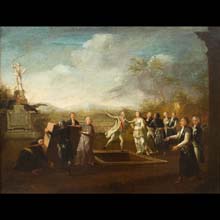
material: oil on canvas
dimensions: 46 x 59 cm
description: The painting shows a scene allegorizing the Kościuszko Uprising, which was a response to the creation of the Targowica Confederation and the Second Partition of Poland (1793). It depicts traitors pushing the personification of Poland, bound in fetters, towards the grave and preparing a tombstone for her. Tadeusz Kościuszko stops Polonia from falling down, pointing at a statue of himself in the pose of the Archangel Michael, with a raised sabre, holding the Constitution of May 3, 1791 in his hand. According to Ambroży Grabowski, a historian and chronicler from Krakow, Stachowicz, “a fervent admirer of the Commander,” included several historical figures in his work, among others, the Targowica confederates: Stanisław Szczęsny Potocki – Marshal of the Targowica Confederation, Franciszek Ksawery Branicki, Bishop Józef Kossakowski and Piotr Ożarowski, and the patriots, visible in the foreground: Ludwik Wilga and Ignacy Potocki. The painting, which introduced a motif of the “grave of the fatherland” to the national iconography, was often reproduced, among others, by Konstanty Kopff and Franciszek Smuglewicz. Wacłąwa Milewska
exposition: The Gallery of 19th Century Polish Art in Sukiennice,
The Cloth Hall, 1, Main Market Square
key: Romanticism. Towards national art >>>
dimensions: 46 x 59 cm
description: The painting shows a scene allegorizing the Kościuszko Uprising, which was a response to the creation of the Targowica Confederation and the Second Partition of Poland (1793). It depicts traitors pushing the personification of Poland, bound in fetters, towards the grave and preparing a tombstone for her. Tadeusz Kościuszko stops Polonia from falling down, pointing at a statue of himself in the pose of the Archangel Michael, with a raised sabre, holding the Constitution of May 3, 1791 in his hand. According to Ambroży Grabowski, a historian and chronicler from Krakow, Stachowicz, “a fervent admirer of the Commander,” included several historical figures in his work, among others, the Targowica confederates: Stanisław Szczęsny Potocki – Marshal of the Targowica Confederation, Franciszek Ksawery Branicki, Bishop Józef Kossakowski and Piotr Ożarowski, and the patriots, visible in the foreground: Ludwik Wilga and Ignacy Potocki. The painting, which introduced a motif of the “grave of the fatherland” to the national iconography, was often reproduced, among others, by Konstanty Kopff and Franciszek Smuglewicz. Wacłąwa Milewska
exposition: The Gallery of 19th Century Polish Art in Sukiennice,
The Cloth Hall, 1, Main Market Square
key: Romanticism. Towards national art >>>












